
|
|||
|---|---|---|---|
|
|
Age of men’s and women’s beach volleyball world tour champions (1987 to 2011) La edad de las mujeres y de los hombres del circuito mundial de beach voleibol (1987-2011) |
|
|
|
*Faculty of Sport. University of Porto (Portugal) ** Faculty of Sport Science. University of Murcia (Spain) *** Center of Health Sciences. University of State Ceara (Brazil) |
Alexandre Igor Araripe Medeiros* José Manuel Palao** Adriano Loureiro*** José Afonso* Isabel Mesquita* |
|
|
|
Abstract The purpose of this study was to analyze the age at peak performance in men and women athletes of beach volleyball, and also the evolution from 1987 to 2011. This paper realized a retrospective analysis of FIVB’s Beach Volley World Tours, in a total of 25 men’s teams (1987-2011) and 20 women’s teams (1992-2011) that have finished the World Tour in 1st place. The results found show: 1) In males, diggers are older than blockers, an average of one year (28.3 years old and 29.8 years old, respectively); and 2) In females, diggers and blockers have similar age (28.2 years old). Keywords: Age. Beach volleyball. World Tour.
|
|||
|
|
EFDeportes.com, Revista Digital. Buenos Aires - Año 17 - Nº 170 - Julio de 2012. http://www.efdeportes.com/ |
|
|
1 / 1
Introduction
Performance is a multidimensional concept, comprising great complexity. It is the main target of a well structured training process – the evolution of the athlete’s and teams’ abilities in pursue of higher performances. Throughout a sports career, athletes and teams progressively elevate their performance level; to get to this point, a great amount of deliberate practice is needed. According to (SIMON e CHASE, 1973), a minimum of 10 years is required for expert performance to be achieved. Although the scope of deliberate practice is an increase in performance ability, biological constraints cannot be stopped. Hence, ageing is an irreversible process, one that will, inevitably, culminate in a phase of performance reduction. Thus, knowing when athletes reach their highest performances will assist in determining: a) the range of peak performance age in beach volleyball; and b) the age at which their performance starts declining. This topic has been studied in other sports (Table 1).
Table 1. Ages at initiation and peak performance in sport (Adapted from Delgado, et al., 1997; Platonov, 1993)
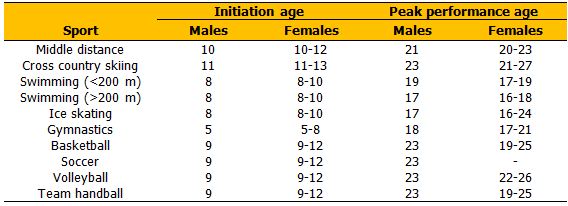
Foremost, the studies above reveal that peak performances are obtained at different ages, whether men or women are concerned. It is known that women maturate about two years earlier than men (Malina & Bouchard, 1991), and that there are substantial differences in both sexes development after puberty (Malina & Bouchard, 1991). It is expected that this will alter the performance curve patterns. These differences make not possible to compare the data from both gender.
In beach volleyball, in the review realized, only one work studied the peak performance rang of age in beach volleyball (to our knowledge) has been found. The study of Palao et al. (2008) found average age of 30.26 (±3.50) in male players and 29.03 (±3.85) in female players who participated in the World Tour and in the Olympic Games (season 2000-2006). They found than in males the blocker were significant younger than diggers (29.45 years old vs 30.56 years old, respectively). These differences were not found in female players. The data of this study showed the range and general values from the 50th first players of the World Tour Ranking. However, these data does not show when the maximum performance is achieved. Thus, the purpose of this study was to analyze the age at peak performance in men and women athletes of beach volleyball, and also the evolution from 1987 to 2011.
Methods
This paper realized a retrospective analysis of FIVB’s Beach Volley World Tours, in a total of 25 men’s teams (1987-2011) and 20 women’s teams (1992-2011) that have finished the World Tour in 1st place. Therefore, data from age in the moment that World Tour was won was gathered relating 46 men and 36 women. Players’ roles were establishment to consultation with former players and beach volleyball coaches. Data was obtained from the website of the Fédération Internationale de Volleyball (http://www.fivb.org/). Descriptive statistics were applied in order to obtain the mean, standard deviation, median, maximum, minimum, range, and mode of the age, both for men and for women. An inferential analysis was done to study the differences between blockers and diggers in males and female beach volleyball players (T-test for independent samples), and between the male and female blockers and diggers (One-way ANOVA).
Results
Table 1 presents the descriptive results of the age of the men´s and women’s FIVB beach volleyball world champions. The age was similar in men and women in the different values found (Graph 1 and Graph 2). Significant differences were found between male blockers and male diggers.
Table 1. Descriptive values of the age of the men´s and women`s beach volleyball world champions
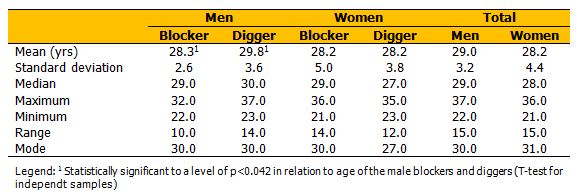
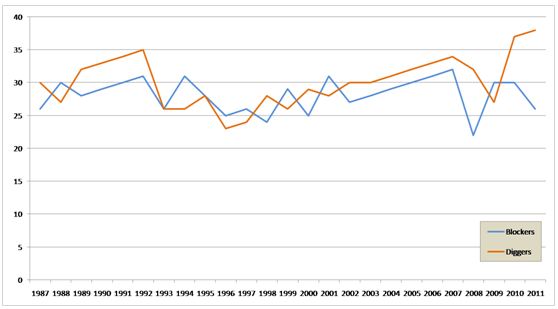
Graph 1. Evolution of age of the men´s beach volleyball World Tour from season 1987-2011
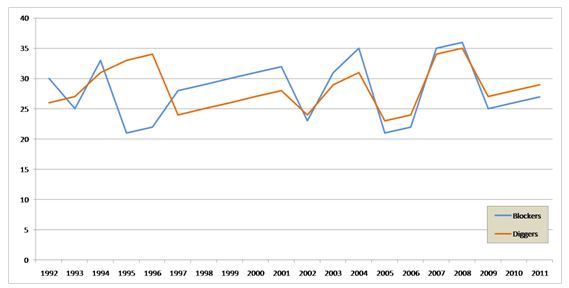
Graph 2. Evolution of age of the women´s beach volleyball World Tour from season 1992-2011
Discussion
In males, the results found show that diggers are significant older than blockers, an average of one year. The reasons of these results are caused by the skills that the players have to do in these roles. Blockers have to be more physical activity (principally jumps) and diggers have to read more the game (principally the clues given by the spiker). These results confirm the data found by Palao et al. (2008) in 50th first players classify in the World Tour. The range of ages found are also similar: blockers have between 25.7 and 30.9 years old and diggers have 26.2 and 33.4 years old. This tendency is also confirm by the maximum age (32 for blockers and 37 for diggers). The results found differ from the general values given for peak performance age in volleyball. These differences are caused probably for the characteristics of the sport. Beach volleyball requires more experience (need or ability to read the game). In fact, there are more World Tour championships older than 30 years old than younger of 25 years old (15 cases out of 48 and 4 cases out of 48, respectively) in both roles.
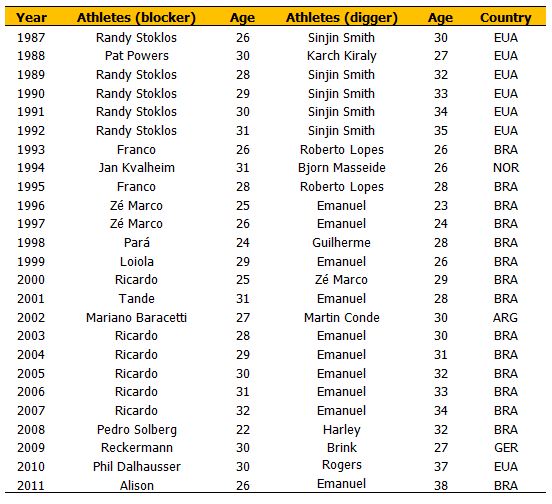
In females, the results found show that diggers and blockers have similar age. In females teams, the theoretical more physical requirements/demands of the blockers or the needs of more ability and experience to read the game of the spiker are not reflect on the relationship of the age between players of the teams. These results confirm the data found by Palao et al. (2008) in 50th first players classify in the World Tour. The range of ages found are also similar: blockers have between 23.2 and 32.3 years old and diggers have 24.4 and 32.0. In females, the range of age of the players is wider than in male. The results found differ from the general values given for peak performance age in volleyball in the superior limit.
From a general perspective, the results shows that in female competition there are a higher number of players under 25 years old that won the World Tour Championship than in men competitions. Another tendecy is that the data are influence by differente teams that have dominanted the competition in diffirent moment. Therefore, the graphs show an increase a constant increase in the age of the players because this team is winning age the competition but they are a year older. The data found does not show variation in the age of the players in the last twenty year, except in defenders male where in the last eigth years has been an increase of the age of the winners’ players (players theoretical with more experience).

Conclusions
The results found show: 1) In males, diggers are older than blockers, an average of one year (28.3 years old and 29.8 years old, respectively); and 2) In females, diggers and blockers have similar age (28.2 years old).
References
-
MALINA, R. M.; BOUCHARD, C. (1991). Growth, maduration, and physical activity. Champaign, IL: Human Kinetics.
-
PALAO, J. M.; GUTIERREZ, D.; FRIDERES, J. E. Height, weight, Body Mass Index, and age in beach volleyball players in relation to level and position. Journal of Sports Medicine and Physical Fitness, [S.l.], v. 48, n. 4, p. 466-471, 2008.
-
SIMON, H. A.; CHASE, W. G. Skill in chess. American Scientist [S.l.], v. 61, p. 394-403, 1973.
Another articles in English
 |

Búsqueda personalizada
|
|---|---|
|
EFDeportes.com, Revista Digital · Año 17 · N° 170 | Buenos Aires,
Julio de 2012 |
|